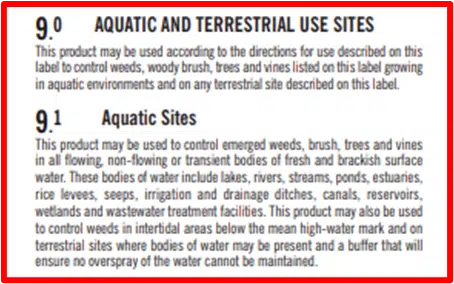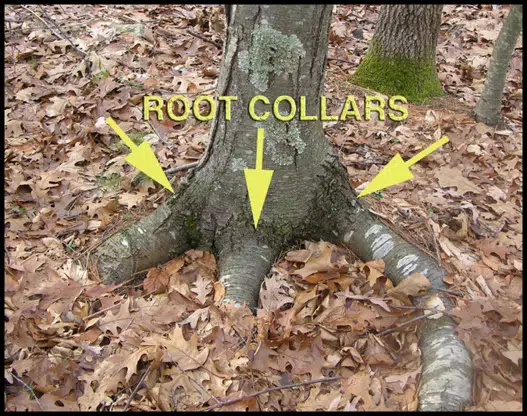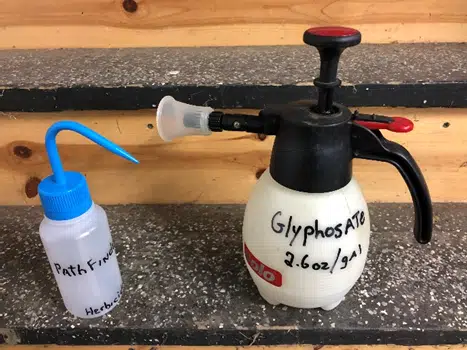10 Most Important Questions about Winter Herbicide Applications
January 24, 2022

In the Horticulture Department, we take advantage of slower-paced winter days to do dormant cut-stump herbicide applications on invasive woody plants. There are other methods to treat larger-diameter trees, but because we most often deal with shrubs (like honeysuckle, privet, and buckthorn) and woody vines (like porcelainberry and grape vine) that range in diameter from ¼”-3”, the cut stump method is best for us.
- Can I use this herbicide near a body of water?
Cut-stump herbicide treatments are much more pinpointed than when applying herbicides through spraying. Many herbicides are not aquatic-approved. If they are mishandled and end up in the water (via human error, flash-rainstorms, etc.), they could cause serious harm to aquatic organisms and even pose a threat to drinking water. If label language is vague, err on the side of caution and keep a buffer of 15-20 feet from the water.


2. What are carrier and penetrants?
They’re products that are mixed with the herbicide to allow it to penetrate deeper into the plant, to give it a better chance of killing the plant. Some herbicides already have a carrier or penetrant mixed into the formulation. Other herbicides do not come pre-mixed, and you must do the mixing yourself.
This is especially important if you’re switching between various products with the same active ingredient. For example, Roundup Custom comes pre-mixed with carriers and penetrants, but there’s a good chance that a generic glyphosate product does not have any carriers and penetrants already mixed in.
3. What temperature extremes can your herbicide handle?
If in doubt, err on using them on days well above the approved temperatures. Because, if the stem is frozen, there’s a good chance the herbicide will be ineffective. And, if, say, the herbicide you’re using can work down to 32°F, use it on a day when the LOW is 32°F—rather than the HIGH being 32°F. This ensures that the stem definitely started out not frozen.
4. What herbicides do we use in the winter at The Holden Arboretum?
Currently, the two main ones we use are Pathfinder II (with active ingredient triclopyr) and Roundup Custom (with active ingredient glyphosate). Pathfinder II works well in cold winter weather (potentially down to 20°F), but, because it’s not aquatic-approved, we keep a 10-foot buffer from any body of water.
Both herbicides come pre-mixed with carriers and penetrants.

We recently noticed that there is a gap in our winter cut-stump protocol: In areas near water, when the temperature is less than 40° F, we don’t have an acceptable herbicide to use. The current plan is to try out a new herbicide called Vastlan. Like Pathfinder II, Vastlan is also a triclopyr, but it’s a more sustainable triclopyr, because it’s aquatic-approved, and it poses slightly less risk to the humans who handle it. Another thing to keep in mind is that many states have already banned glyphosate, so we may need to accommodate for a future ban on glyphosate in the state of Ohio. So that means switching to other active ingredients, like triclopyr.
5. How do you cut a woody plant before applying the herbicide?
The key is to cut it down to the root collar. This region is also known as the root flare, and it’s this fairly obvious point where the trunk flares out before going underground to the roots. Cutting your stump too high means the herbicide needs to travel further to get to the roots, and it also presents a tripping hazard. For maximum effectiveness, make the cut no more than an inch or two above the collar.

Important to note is that you should apply the herbicide as soon as possible after making the cut. The longer you wait, the quicker the cambium will begin to heal over—and then it’ll be more difficult for the herbicide to penetrate—though carriers and penetrants do help overcome a slightly-delayed application time.
6. What is the cambium?
The most important part of the cut-stump to treat is the cambium. The cambium is a cell layer immediately under the bark, which encircles the rest of the sapwood and heartwood. It’s the growing part of the trunk, and each year, it produces new bark and new wood.


With larger stumps (as in the above photo), only painting the cambium allows for a more targeted approach, which wastes less product and is also more sustainable.

With stumps less than 3” in diameter (as in the above photo), the whole cut-stump should be painted.
7. What’s the best way to apply herbicide to the cut?
We use four different methods, and different staff-members prefer different methods. The key is to use the method that is easiest for you to apply the herbicide in a safe and precise way.

One method is to use a Nalgene bottle (with the blue applicator tip) to carefully squirt herbicide onto the cut. Another method is to use a pressurized pump sprayer, though this one is probably best for larger applications which require less precision.

Another is to use a “Kill Stick”, which is a PVC pipe with a felt applicator tip. Because of its length, it allows the worker to stand upright while making most applications. The biggest problem, though, is that you don’t know how much herbicide is actually going onto the cut because the PVC pipe is opaque.

The final option is to use a Buckthorn Blaster applicator. These are nice because you can actually see how much herbicide is used over a period of time. Their applicators function like a Bingo stamper, and they seem to apply more product to the cut than the PVC Kill Stick.
8. What’s the benefit of reading the label?
The label contains so much helpful and definitive information. It also has a lot of vague language that prompts questions such as, how far am I supposed to stay away from the water when using it? And, how low am I supposed to cut a shrub down for the cut-stump treatment to be the most effective?


9. If you have any questions, whom should you contact?
Really, the first line of questioning should go to your state’s extension agents. The Ohio State University has some great extension agents who are very helpful and can clarify a lot of the vague language or jargon.
If you have additional questions, you can reach out to the Ohio Department of Agriculture (ODA). Many people think that the Environmental Protection Agency (EPA) is responsible for the enforcement of pesticides. But, actually, the EPA is responsible for the wording found in the label, and the ODA is responsible for enforcing federal and state pesticide laws.
OSU Extension:
- Boggs, Joe boggs.47@osu.edu
- Draper, Erik draper.15@osu.edu
- Smith, Kathy smith.81@osu.edu
ODA:
- Pesticides@Agri.ohio.gov
10. What if you’re thinking about switching to a different herbicide?
Maybe you’ve heard of a “greener” herbicide. Or, maybe you want to try a “safer” herbicide. The best way to decide if the new herbicide works as well as or better than your old one is to set your land up in physical or imagined experimental plots. Only use one type of herbicide per plot, and record the number and size of sprouts in the next growing season. If this safer, greener herbicide seems to work well, make the switch!

Rob Maganja
Horticulturist
Rob Maganja graduated from Hiram College in 2013 with a BA in Environmental Studies. He started as a seasonal at the Holden Arboretum in 2013, and in the 8 years since, has worked several more seasons in all the different gardens. Additionally, he’s spent time with the United States Peace Corps in Cameroon and was an IPM intern at Longwood Gardens. He currently is the horticulturist of the Rhododendron Discovery Garden and is also one of the stewards of Holden’s Core Natural Areas. He looks forward to the Core Natural Areas becoming a bona fide agroforestry demonstration.













